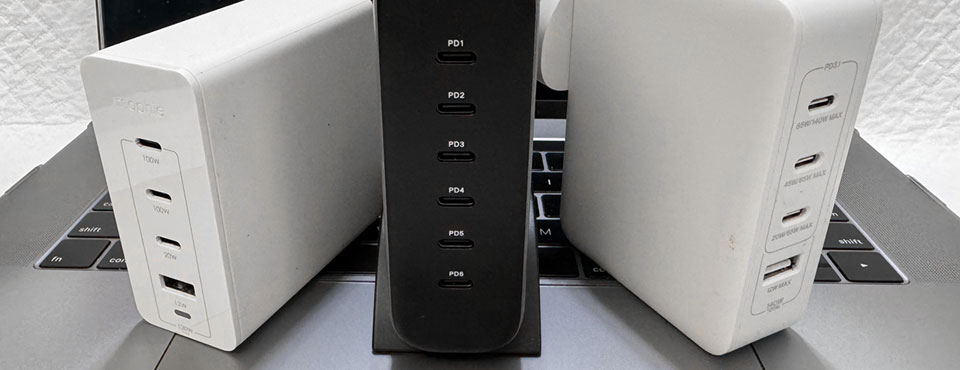Multi-port USB PD chargers have taken the market by storm as the demand for a hub capable of charging multiple devices continues to grow. Furthermore, the growing trend of smartphones no longer including power bricks, both as a cost-saving measure and an effort to reduce e-waste, has fueled the USB PD charger market. Since most of us routinely need at least three or more ports to keep our devices charged, multi-port USB chargers naturally become a more convenient choice over single-port options.
Contents
Current State of Multiport USB PD Chargers
The market is also transitioning fast from silicon-based to GaN-based chargers. One of the main advantages over silicon is that GaN enables smaller transistor size, resulting in higher efficiency at conducing electricity and lower energy loss. In other words, this leads to more compact power bricks without sacrificing power capability and risking overheating. GaN is being adopted by manufacturers in favor of silicon especially on the heavy-duty USB PD chargers like the ones we tested here.
The introduction of USB Power Delivery 3.1 raises the bar once again for fast-charging with the ability to pump up to 240W over Extended Power Range (EPR) USB-C cables when paired with a compatible power adapter and device. This is up from the maximum 100W provided by PD 3.0. In most use cases, gaming and content creation laptops equipped with a discrete GPU benefit greatly from this power boost. Some high-capacity power banks also take advantage of this even faster charging option with their 140W power input.
As of early 2024, manufacturers has begun to integrate USB Power Delivery 3.1 into their multiport chargers, with at least one 140W (28V / 5A) port. However, power available from such a port would get rerouted as soon as other USB-C ports are also in use. This is a common characteristic of most multi-port chargers, where wattage output drops based on the number of active ports and their respective power draw. As such, it’s worth the time to consult the wattage distribution charts available from the manufacturers to determine the optimal charging configurations for your devices.
Chargers Chosen for the Tests
We have chosen three USB PD GaN chargers from Belkin, Mophie, and Satechi for comparison, and intend to add a few more in the following months. While there is a bewildering array of choices, the top-tier brands tend to provide better quality control and likely have a better track record of customer support should any issues arise.
Satechi 200W GaN 6-port Charger
Each of these three chargers can handle at least one high-powered (i.e. 100W or 140W) power-hungry laptop. Between these power bricks, the Satechi 200W GaN charger packs a punch with its six-port charging capability. While its 200W rating is being marketed as total output, the adapter guarantees 100W charging for up to two devices simultaneously.
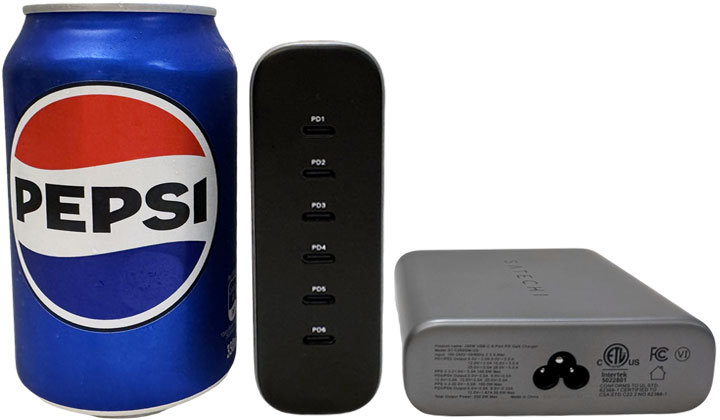
Measuring at 105 by 105 by 35mm (LWH) and weighing at 622g, the Satechi is quite a bit bulkier and heavier than the other two chargers tested here. Its 1.5m C5 power cable further adds to the travel weight. We like to consider the Satechi more of a desktop charging station than a mobile charger. When sitting upright on its own, the charger isn’t particularly stable and the accompanying stand helps. Satechi 200W GaN charger is backed by a one-year warranty.
Belkin BoostCharge Pro 140W
Belkin BoostCharge Pro 140W is a wall charger that is only two-thirds the size and half the weight compared to Satechi’s heavy-duty power brick. It delivers three USB-C ports in addition to one USB-A socket for a total power output of 140W. Its 140W rating is being marketed as the unit’s total power output as well as the maximum output for the charger’s topmost USB-C port.
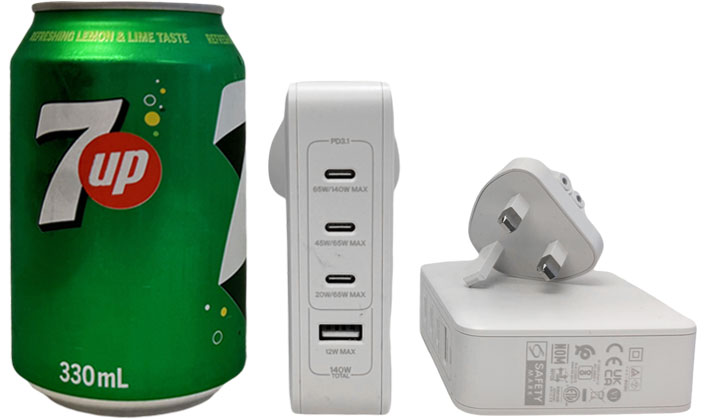
Frequent travelers will come to appreciate interchangeable plugs. Though, it depends which version you are getting. The US-version apparently only ships with a foldable prong. The BoostCharge Pro is a wall charger, and as such, where you can place your devices is limited by the length of USB-C cables. Belkin offers a one-year warranty on the product.
Mophie SpeedPort 120 Charger
Mophie SpeedPort 120 – measuring at 80 by 80 by 36mm (LWH) – is close to Belkin BoostCharge Pro in terms of size. With this charger, you get three USB-C ports and a legacy USB-A port. The “120” in the name again refers to the 120W total output. The maximum output for the topmost port is 100W if that is the only port you are going to use. The charger comes with a 1.5m AC power cable and a two-year warranty.
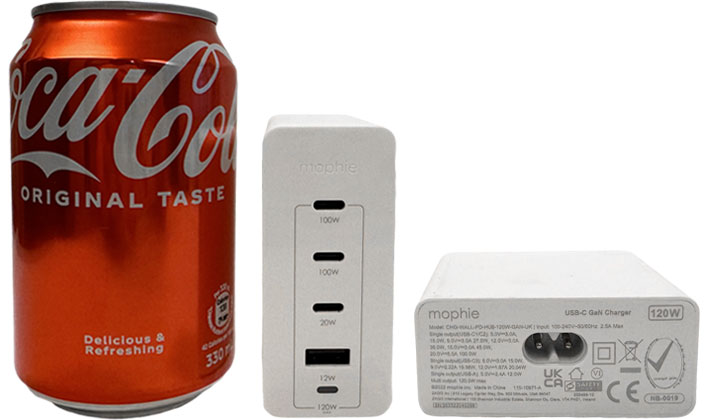
None of these chargers comes with an activity light for each of their ports. There’s no telling if a USB port is supplying power unless the connected mobile devices give indications. Among these chargers, only the Satechi 6-port 200W charger and the Belkin BoostCharge Pro 140W have obtained Intertek’s ETL certification whereas Mophie’s CE marking indicates that the charger does not meet additional voluntary safety standards. Also, do note that we couldn’t find any multi-port chargers to be USB-IF certified.
Feature Comparison
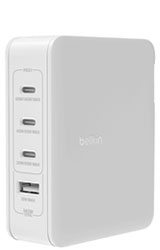 Belkin BoostCharge Pro 140W Charger $57.95 | 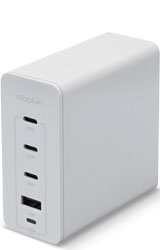 Mophie speedport 120 Charger $79.96 | 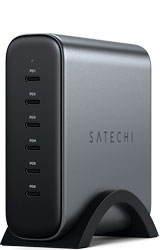 Satechi 200W 6-port Charger $115.35 |
|
|---|---|---|---|
| Total Power Output: | 140W | 120W | 200W |
| Power Port(s): | 3x USB-C 1x USB-A | 3x USB-C 1x USB-A | 6x USB-C |
| Maximum Wattage Output by Port: | 140W (Port 1) 65W (Port 2) 65W (Port 3) | 100W (Port 1) 100W (Port 2) 20W (Port 3) | 140W (Port 1) 140W (Port 2) 100W (Port 3) 100W (Port 4) 20W (Port 5) 20W (Port 6) |
| Fully-loaded Charging Output: | 65W (Port 1) 45W (Port 2) 20W (Port 3) 12W (USB-A) [source] | 67W (Port 1) 20W (Port 2) 20W (Port 3) 12W (USB-A) | 65W (Port 1) 45W (Port 2) 20W (Port 3) 20W (Port 4) 20W (Port 5) 20W (Port 6) [source] |
| USB-A Output: | 5V 2.4A (12W) | 5V 2.4A (12W) | Not applicable |
| Interchangeable Plugs? | Yes | No | No |
| Power Cable Length: | Not applicable | 1.5m power cable | 1.5m C5 power cable |
| Safety Standard Compliances? | Intertek's ETL | Intertek's ETL | |
| Dimensions: | 80 x 80 x 36mm | 75 x 95 x 31mm | 105 x 105 x 35mm |
| Weight: | 344g | 453g | 622g |
| Warranty: | One year | Two years | One year |
Pricing is last updated by Amazon on 2026-01-01 at 05:23. When you buy through Amazon affiliate links on our site, we may earn an affiliate commission.
Single-port Charging Performance
The purpose of our tests was to find out if trading a stock charger for another power brick would have an impact on the charging performance. To that end, we recorded the battery life every 10 minutes while charging each device from 10 to 90% of its battery capacity. The screens on the devices were on sleep mode during the charging sessions until we had to wake them up to check the battery. We were able to gauge the the wattage pulled by each device with Plugable’s USB-C Power Meter.
For the first set of tests, we separately paired our MacBook Pro 15-inch, iPhone 15 Pro Max, and iPad Pro 12.9-inch with each of the three USB PD chargers to determine if there is a difference in charging performance compared to using a stock charger.
We began with MacBook Pro. Its 87W stock power adapter was able to charge our 15-inch laptop from 10 to 90% in 84 minutes. Both Mophie and Satechi charger could also achieve that in 80 minutes while Belkin did it in 84 minutes. All three third party chargers were able to match the charging speed of Apple 87W stock charger.
Moving on to iPad Pro, Apple’s 20W stock charger took a mind-blogging 136 minutes to charge the tablet from 10 to 90%. It is far from reaching the iPad’s maximum charging capability at around 36W. In comparison, Belkin did it 95 minutes while Satechi finished second at 100 minutes. Mophie completed the charge to 90% at 110 minutes and it took 15 minutes longer than Belkin to complete the test. Upgrading the power brick is a no-brainer as Apple iPad Pro can charge much faster with one of the three tested USB PD chargers.
For the iPhone 15 Pro Max, we carried out the tests with Apple’s own 20W power adapter as iPhone no longer ships with a charger. That said, this single-port USB-C charger likely would have been bundled had Apple continued practice of including one with their phones. Apple’s 20W power adapter during our tests managed to charge our iPhone to 88% in 70 minutes. In the same amount of time, Belkin, Mophie, and Satechi hit the mark 93%, 91% and 94% respectively.
Multi-port Charging Stress Tests
Next, we also did a stress test on the USB PD chargers to determine if the chargers have what it takes to handle the workload. To that end, we simultaneously charged three devices (i.e. iPad Pro 12.9-inch, MacBook Pro 15-inch, and iPhone 15 Pro Max) and recorded the battery life every 20 minutes until our timer hit 80-minute mark. The screens on the devices were on sleep mode during the charging sessions until we had to wake them up to check the battery. Again, we were able to gauge the the wattage pulled by each device with Plugable’s USB-C Power Meter.
As the Satechi 200W GaN charger comes with an impressive six USB-C ports, we decided to test only three of the Satechi’s six USB-C ports in order to match Belkin’s and Mophie’s three-port charging capabilities for comparison sake. Also, USB-A ports on the latter two chargers appear to work independently of USB-C and for that reason, we didn’t include the legacy USB ports in the stress test.
| Tested Chargers | Connected Device(s) | Input Port | 20 minutes | 40 minutes | 60 minutes | 80 minutes |
|---|---|---|---|---|---|---|
| Apple 87W Charger | Apple MacBook Pro | Port 1 (87W) | 35% | 56% | 74% | 87% |
| Apple 20W Charger | Apple iPad Pro | Port 1 (20W) | 23% | 37% | 50% | 62% |
| Apple 20W Charger | Apple iPhone 15 Pro Max | Port (1 (20W) | 39% | 67% | 83% | 94% |
| Belkin 140W Charger | Apple MacBook Pro | Port 1 (65W) | 43% | 64% | 80% | 93% |
| Apple iPad Pro | Port 2 (45W) | 32% | 54% | 72% | 84% | |
| Apple iPhone 15 Pro Max | Port 3 (20W) | 40% | 68% | 84% | 95% | |
| Mophie 120W Charger | Apple MacBook Pro | Port 1 (67W) | 33% | 54% | 72% | 85% |
| Apple iPad Pro | Port 2 (20W) | 25% | 38% | 52% | 57% | |
| Apple iPhone 15 Pro Max | Port 3 (20W) | 40% | 68% | 84% | 91% | |
| Satechi 200W Charger | Apple MacBook Pro | Port 1 (100W) | 37% | 59% | 76% | 89% |
| Apple iPad Pro | Port 2 (45W) | 33% | 55% | 74% | 87% | |
| Apple iPhone 15 Pro Max | Port 3 (45W) | 40% | 69% | 85% | 95% |
When dealing with multi-port charging scenario, your mileage varies greatly as each charger allocates wattage across its USB-C ports differently. For instance, when all USB-C ports on Belkin BoostCharge Pro with a total power output of 140W are in use, the power distribution is as follows: 65W, 45W, 20W. If you want the uppermost port to supply 140W of power, you are bound to single-port charging and cannot have anything connected to the other ports. For 100W charging, you can still use the USB-A port for 12W output. Peak temperature reached 56°C after 40 minutes of use, but we didn’t run into thermal-related issues.
Situation with Mophie SpeedPort is that there just isn’t enough power to go around. In a three-port charging configuration, you are limited to 67W, 20W and 20W of power per port. This adds up to 107W, but there’s still 12W reserved for USB-A from the charger’s 120W of shared output. Between Mophie and Belkin, the latter fared better in our test as its second USB-C port can pump 45W to super-charge our iPad Pro while maintaining wattage output for our laptop.
Things get a little more complicated with Satechi 200W charger. With six USB-C ports at your disposal, you literally have fifty-nine different combinations to connect your devices, according to the “Power Schematic” table in the manual. Dual 100W charging is possible with Satechi so is a single 140W output if you are fine with just that another port pumping 20W. Seeing our test was to gauge charging performance on a triple port output, we ended up with this configuration – 100W, 45W, 45W. Peak temperature was around 44°C after 40 minutes of use.
Reliability and Warranty Options
We’ve had these chargers for quite some time. Unfortunately, after eight months, two of the USB-C ports (ports 4 and 5) on the Satechi 6-port 200W charger stopped working, and after fourteen months, the topmost port on the Mophie SpeedPort 120 charger also experienced the same failure. Oddly, the unresponsive ports on the Satechi were not used as frequently as the others.
While everyone’s mileage may differ, there is an increased likelihood that at least one port will fail over time with multi-port chargers. For this reason, it’s worth exploring warranty options before problems arise. Luckily for us, both the Mophie and Satechi chargers failed within their respective warranty periods – two years for the Mophie and one year for the Satechi.


